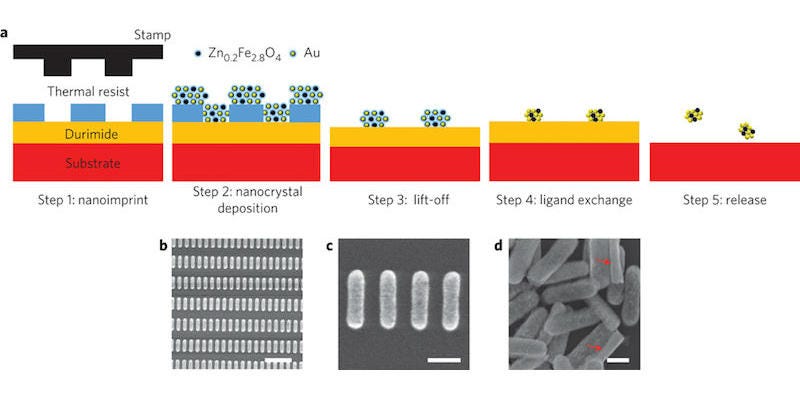Penn Engineers Demonstrate a ‘Hybrid Nanomanufacturing’ System

Researchers at the University of Pennsylvania’s School of Engineering and Applied Science have demonstrated a way to make nanorods that have a useful mix of optical and magnetic properties.
Nanoscale structures have properties that can’t be achieved in any other way, stemming from precise control over the structure’s composition and geometry. Unfortunately, simultaneously achieving high levels of control of both characteristics can be challenging. Bottom-up, self-assembly methods can carefully tailor the chemical makeup a nanoparticle, but are limited in their ability to control the shape or size of nanostructures build from these small components. Conversely, top-down fabrication techniques can make nanostructures to exact geometric specifications, but often sacrifice the properties that come from their control of the chemical composition at near-atomic dimensions.
Researchers at the University of Pennsylvania’s School of Engineering and Applied Science have demonstrated a way to combine these two approaches to make nanorods that have a useful mix of optical and magnetic properties.
Composed primarily of gold nanoparticles, these rods resonate with certain frequencies of polarized light, but only when they are lined up in the same direction. Combining these gold nanoparticles with ones made of zinc ferrite makes them “superparamagnetic,” meaning they will change direction in response to an external magnetic field.
The combination of those two properties means they could be used in applications like “smart windows,” which would adjust the wavelengths of light they transmit on command. Being able to tailor the specific length-to-width ratio and size of these nanorods means the Penn team can control which parts of the electromagnetic spectrum they interact with.
The researchers’ hybrid nanomanufacturing technique also shows a more scalable path to producing different kinds of custom nanostructures on demand, using nanocrystal-infused colloidal “inks” and engraved templates similar to those found in a lithographic printing press.
The engineers’ study was published in Nature Nanotechnology. It was led by Cherie Kagan, the Stephen J. Angello Professor in the departments of Electrical and Systems Engineering and Materials Science and Engineering, and Mingliang Zhang, a member of her lab.
Christopher Murray, a Penn Integrates Knowledge Professor with appointments in the Departments of Materials Science and Engineering in the School of Engineering and Applied Science and in Chemistry in the School of Arts & Sciences, Nader Engheta, the H. Nedwill Ramsey Professor of Electrical and Systems Engineering, and James Kikkawa, a professor in Arts & Sciences’ Department of Physics & Astronomy, also contributed to the work.
Nanotechnologists are interested in new ways of making “smart” materials — ones that can change in response to external stimuli, like light, heat or magnetic fields. Rod-shaped structures made out of gold nanoparticles can interact, scatter or block different wavelengths of light depending on their orientation. If there were a way of remotely controlling the rotation of those particles, they could be used in a variety of applications, such as a “smart” window.
“Being able to change the amount of infrared light a window blocks would be great for heat management,” Kagan said. “You could change the orientation of the particles based on the season or the time of day.”
Such combinations of optical and magnetic properties don’t come naturally, however. The Penn researchers aimed to address this by infusing gold nanorods with superparamagnetic zinc ferrite particles.
The challenge was to maintain the right balance of particles while simultaneously controlling the size and shape of the finished structure.
“The gold particles act as a kind of scaffold into which the zinc ferrite particles are added,” Zhang said. “But we needed to combine two manufacturing techniques to get the right ratio of gold to zinc ferrite — 3 to 1 in volume — while also keeping the right shape. The specific geometry of the rods is what determines the plasmonic frequency, the spectral range of light they interact with”
Kagan’s and Murray’s groups have extensive experience in making colloidal nanoparticle “inks” out of mixtures of particles. Fittingly, they combined this technique with one that is used in human-scale printing: imprint lithography.
There, an ink consisting of gold and zinc ferrite nanoparticles is poured into nanorod-shaped divots that are cut to specification.
“One of the advantages,” Kagan said, “of combining [bottom-up] fabrication and [top-down] lithography is that it gives us that geometric control. The bottom-up part gives us the physical properties [that stem from the gold/zinc ferrite ratio] — and if we use lithography, that allows us control the size scale, and that will allow us to control the spectral range they operate at. [Moving out of the infrared and visible light range could open up applications in biomedical imaging, for example.]”
This hybrid approach also presents a highly scalable way of “nanomanufacturing” smart materials with unique combinations of properties.
